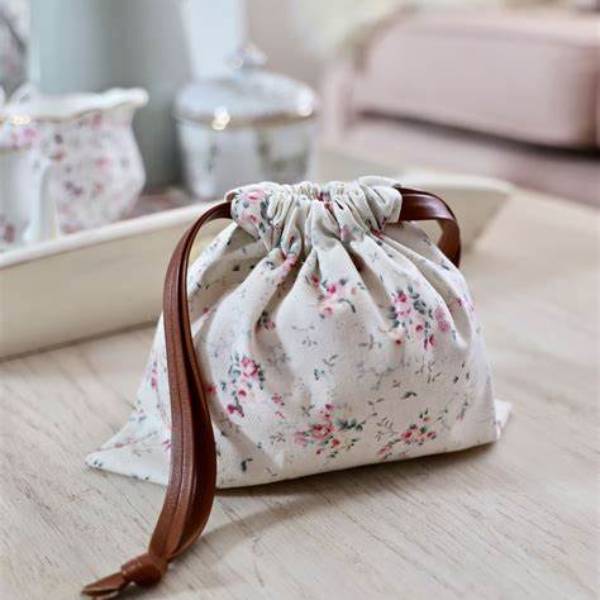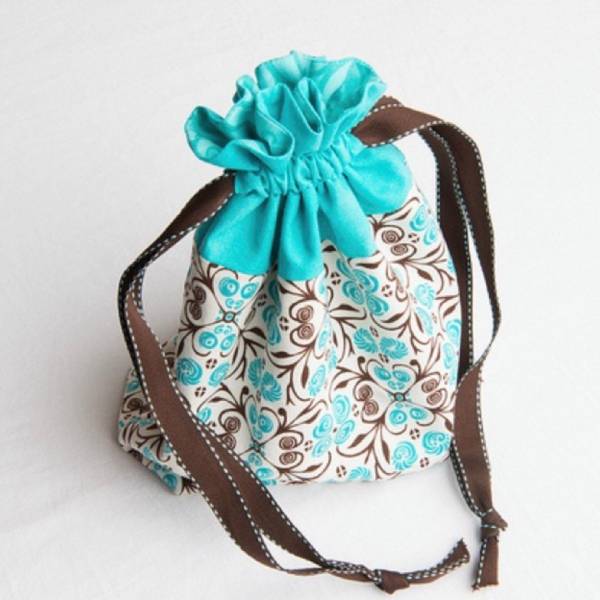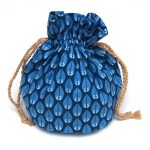Introduction to Drawstring Bags
How to make a drawstring bag serve as a versatile solution for everyday storage and transport needs. From organizing small items to serving as eco-friendly gift wrap, these bags prove their utility in numerous situations. Their customization options make them a favorite for crafters and DIY enthusiasts alike, allowing creativity in design and function.
Drawstring bags are incredibly simple to make, which makes them perfect for beginners in sewing. If you’re looking for a project that requires minimal materials and offers room for artistic expression, creating a drawstring bag is an excellent choice. The process involves straightforward sewing techniques that even novices can master with ease.
One of the best features of drawstring bags is their collapsibility. When not in use, they can be folded and stored away without taking up much space. This makes them ideal for travelers or for those living in smaller spaces. Drawstring bags also tend to be durable and reusable, aligning with environmentally conscious practices by reducing the use of disposable bags.

Whether you’re planning to make a simple pouch to hold your treasures, a produce bag for your market visits, or a custom gift bag, learning how to make a drawstring bag is a skill that offers endless possibilities. In the following sections, we’ll cover the materials you’ll need, how to prepare your fabric, and provide you with step-by-step sewing instructions to create your own unique drawstring bag.
Essential Materials for How to make a drawstring bag
To start your project, you’ll need a few basic items. Gather your fabric, which can be cotton, canvas, or linen, as these are sturdy and work well for bags. Choose a drawstring material, like cord, ribbon, leather strips, or twine. You’ll also need a sewing machine or needle and thread for hand stitching, scissors for cutting fabric, and a ruler or measuring tape for sizing. When preparing to create a travel makeup bag, be sure to gather sturdy fabrics like cotton or canvas, a suitable drawstring material, and essential sewing tools to bring your project to life.
Choosing the Right Fabric
Selecting the right fabric is crucial for your drawstring bag. Cotton is lightweight and easy to work with, perfect for small organizers or gift bags. Canvas and linen provide more durability, making them suitable for laundry or produce bags. When choosing materials for your accessories, consider that while cotton is ideal for lightweight drawstring bags, a leather messenger bag offers a timeless durability and style perfect for everyday use.
Deciding on Drawstring Material
For the drawstring, strength and ease of use are important. Cord and ribbon slide smoothly, while leather strips and twine add a rustic touch. Ensure the length of your drawstring is enough to easily open and close the bag when tied. When selecting a marc jacobs tote bag, consider the drawstring’s durability and functionality; materials like cord or ribbon ensure smooth operation, while leather strips provide a unique, rustic flair. Ensure the length is adequate for easy opening and closing.
Additional Supplies
To ensure neat edges, consider a serger, overlock stitch on your sewing machine, or pinking shears. A safety pin can help thread the drawstring through the casing. For pressing fabrics, an iron and possibly a press cloth can be very helpful.
By starting with the right materials, you prepare for a successful sewing project. With these items in hand, you’re ready to move on to preparing and cutting your fabric to the correct size, which is the next step in creating your personalized drawstring bag.
Preparing the Fabric: Cutting and Sizing
Preparing your fabric properly is a key step in how to make a drawstring bag. First, choose the size of your bag. This depends on what you’ll use it for. Remember, add an inch to both the length and width for seam allowances.
Determine the Size of Your Bag
Think about the bag’s purpose. For small organizers, 8×10 inches is good. For laundry bags, go larger. Measure your fabric accordingly.
Cut the Fabric
Lay your fabric flat. Use a ruler and scissors for precision. Cut one piece for a simple bag, or two for a lined bag. If you’re working with patterned fabric, consider the design placement.
Mark Seam Allowances
After cutting your fabric, mark where you’ll sew. Use chalk or fabric markers. Seam allowances are typically 0.5-1 inch. Be consistent.
Press the Fabric
Iron your fabric before sewing. It helps remove wrinkles and create clean, crisp lines.
By cutting and sizing your fabric carefully, you are setting the stage for a well-made drawstring bag. After these steps, you will be ready to begin sewing your project.
Step-by-Step Sewing Instructions of How to make a drawstring bag
Creating your drawstring bag involves simple sewing steps. Follow carefully for excellent results.
- Lay your fabric flat, with right sides together. Pin along the edges, leaving the top open.
- Sew the sides and bottom of your fabric, forming a bag shape. Use a straight stitch, with a half-inch seam allowance. Backstitch at the start and end for strength.
- Along the top edge, fold down 1 inch to create a channel for your drawstring. Press with an iron to keep it flat.
- Stitch around the bottom of the folded edge to form the drawstring channel. Leave openings on both ends for the drawstring.
- Cut your drawstring material to length. For an 8×10 inch bag, two 30-inch long pieces work well.
- Attach a safety pin to one end of your drawstring. Thread through the channel, ensuring it comes out the same side it entered.
- Repeat with the second drawstring, starting on the opposite side. Doing this creates a closure system.
- Knot the ends of both drawstrings to prevent fraying and slipping through the channel.
- Turn the bag right side out. Press it once more to define the shape. Your drawstring bag is now complete.
Take your time with each step. Straight, consistent seams create a durable, attractive bag. For gifts or personal use, this bag is a simple yet rewarding project.

Adding a Personal Touch: Customizing Your Drawstring Bag
Once you’ve mastered the basics of how to make a drawstring bag, the fun really begins. Customizing your creation adds a unique flair that cannot be bought in a store. You can tailor your drawstring bag to reflect personal style or to make the perfect gift for someone special.
- Choose Vibrant Fabrics: Pick colors or patterns that make you smile. Combining different textures can also add interest.
- Add Embellishments: Consider attaching appliqués, beads, or embroidery. Even simple fabric paint can make a bold statement.
- Play with Sizes: Create a range of bags, from tiny pouches for jewelry to larger ones for shoes or clothes. Adjust the dimensions as needed.
- Incorporate Pockets: Add inside or outside pockets for more storage. This is great for organizing items within the bag.
- Adjust the Drawstring: Swap the standard cord for something more decorative like braided yarn or satin ribbon.
- Lining for Luxury: For a more finished look, add a lining. Choose a contrasting fabric to peek out when the bag is open.
By adding these personal touches, you’ll elevate your drawstring bag from a simple item to a handcrafted treasure. It’s not just the usefulness that makes these bags great, but the personal touch that tells a story. Happy sewing and customizing!
Tips for Sewing a Durable Drawstring Bag
Creating a drawstring bag is not only about aesthetics; durability is key. To ensure your bag withstands the test of time, follow these tips:
- Use Quality Fabric: Pick sturdy materials like canvas, denim, or heavy cotton. These fabrics resist wear and tear.
- Reinforce Seams: Double stitch at the seams for extra strength. This prevents tearing when the bag is full.
- Secure Drawstring Ends: Add fabric tabs at the ends of the drawstring channel. They help to prevent the drawstring from fraying.
- Choose the Right Drawstring: Use a cord or ribbon that is tough yet easy to tie. Avoid materials that stretch or break easily.
- Add Corners to Drawstring Channels: Sew across the bottom corners of the channel. This creates a triangle shape and reduces stress on the fabric.
- Use an Interfacing: If you choose a lighter fabric, use an interfacing. It provides structure and support to the bag.
- Trim and Finish Edges: Prevent fraying with pinking shears or by using a serger.
- Test the Bag: Before using it heavily, fill the bag and test the strength. This ensures that your construction is sound.
Apply pressure to the drawstring and seams to identify any weak spots. If found, reinforce these areas before you start using the bag regularly.
By prioritizing durability, your drawstring bag will serve well for various purposes, from a quick trip to the market to an easy-to-pack travel companion.
Alternative Drawstring Bag Designs
Exploring different drawstring bag designs can add versatility to your crafting repertoire. Here we’ll highlight some alternative styles you might consider.
Backpack-Style Drawstring Bag
A popular variation is the backpack-style drawstring bag. By attaching the drawstrings at the bottom, you create straps. This design leaves your hands free, ideal for day trips or gym visits.
Lined Drawstring Bags
A lined bag offers a luxurious touch and increased durability. Use contrasting fabrics for the lining to add an element of surprise when opened. Plus, it hides seam allowances for a more professional look.
Boxed Bottom Bags
For more structure, add a boxed bottom. This design stands upright and holds more items. It’s excellent for larger objects and maintains the bag’s shape better.
Patchwork Drawstring Bags
Patchwork bags showcase creativity and resourcefulness. Combine fabric scraps to form a unique pattern. It’s an eco-friendly way to use left-over materials.
Clear Vinyl Drawstring Bags
A clear bag made of vinyl is perfect for storing items you want to see. It’s great for travel, making it easy to find what you need fast. Remember, sewing with vinyl might require a special machine foot.
Two-Tone Drawstring Bags
Blend two colors or patterns for a modern, chic look. A two-tone bag can match more outfits or decor, making it a versatile choice.
Water-Repellent Drawstring Bags
Outdoor adventurers can benefit from water-repellent fabrics. These bags protect contents from moisture and are great for camping or hiking.
Choose designs that fit your needs and get creative with fabrics and features. Drawstring bags are not just practical but can also express individual style and personality.

Final Thoughts: The Versatility of Drawstring Bags
Drawstring bags are a true testament to simplicity and functionality. These bags are easy to make, which makes them great for beginners. You can choose different fabrics and sizes to suit your needs. Whether you need a small bag for jewelry or a big one for sports gear, drawstring bags are adaptable.
You can modify drawstring bags to fit your style. Add patches, embroidery, or a mix of fabrics. Make them unique with your choice of drawstring material. For outdoors, pick water-resistant fabric. For a luxury feel, add a soft lining.
These bags also help the environment. They are reusable and reduce the need for disposable bags. Use them for shopping, travel, or home organization. They are light, fold small, and can be used again and again.
Drawstring bags are more than just storage. They show creativity and care for the environment. With each bag you make, you add a personal touch to an everyday item. So get creative and start sewing your own versatile drawstring bags today!

